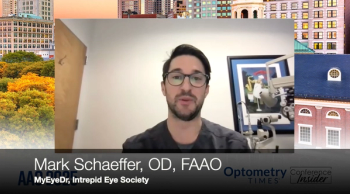
- February digital edition 2020
- Volume 12
- Issue 2
Retinal detachment seals itself
A 24-YEAR-OLD MALE pilot applicant presented for an examination at the Naval Aerospace Medical Institute (NAMI). His history included being an amateur hockey player in his younger years. He reported being hit in the head with a hockey puck plus numerous blows to the head during fights while participating in the sport.
Exam findings
The following examination results were obtained.
Uncorrected visual acuity uncorrected was 20/20 OD and OS.
Refraction was:
OD: Plano-0.75 x 180 20/20
OS: Plano-0.50 x 140 20/20
Stereo vision showed 40 seconds of arc. No tropia was noted, and phorias were within standards. Extraocular movements were full.
Slit-lamp examination with 78 D lens showed normal lids, conjunctiva,
Intraocular pressures with non-contact tonometry were OD 12 mm Hg, OS 15 mm Hg.
With further examination of this patient, a retinal detachment in the left eye was confirmed by Captain Matthew Rings, aerospace ophthalmologist at NAMI. In this particular case, the detachment had appeared to have stopped its progression (see Figures 1 and 2). The patient was referred to a retinal specialist. Dr. Rings said it was possible that the
Navy pilot screening
All aviator applicants are routinely dilated at NAMI using 1% cyclopentolate to rule out excessive hyperopia and to perform a routine dilated fundus exam with binocular indirect ophthalmoscopy. With ophthalmoscopy, I noted an anomaly in the far periphery next to the ora serrata in the left eye of this pilot applicant.
Keep in mind that if a pilot applicant is accepted for flight training, the military will invest millions of dollars in training. The custom-fitted helmet for the F-35 fighter costs $400,000 and features dual cameras for situational awareness in flight for both day and night vision. Because of these costs of training and equipment, the military routinely screens applicants for potential vision and eye diseases before they are accepted for flight training to avoid losing the aviator to progressive eye disease in the middle of a flying career. Such screening maximizes the government’s return on investment and reduces pilot shortages, which is a national defense priority.
Differential diagnosis
My first impression was that I was observing cobblestone degeneration, also known as paving stone degeneration. This retinal detachment (RD) case and paving stone degeneration have similar appearances (see Figure 3). The lesions were round to oval and had scalloped distinct margins. One can see the underlying large choroidal vessels and sclera. There was pigment hyperplasia at the edges of the lesion and pigment migration from atrophied retinal pigment epithelium into sensory retina within the lesion.
Paving stone lesions tend to be aligned in a row parallel to the ora serrata and are commonly found in between the ora serrata and the equator.1
The RD I observed was also in a roll next to the ora serrata. Another optometrist initially thought it might be due to previous laser treatment. However, the patient denied any laser treatment and there was no history of treatment or RD in his medical record.
What helped make the diagnosis of self-sealing RD was that the views of the retinal pigment changes were in focus but peripheral to it, nearer the ora serrata, and the retina was lifted up and out of focus.
Sourcing opinions
There are other options to help detect RDs besides binocular indirect ophthalmoscopy with scleral depression, which was used in this case. I asked for thoughts and techniques from members of online optometric community ODwire.
The members agreed that the OCT is limited to the posterior pole. Joe DiGiorgio, OD, said his spectral domain (SD)-OCT is useful for evaluating images in the posterior pole, but his daughter and practice associate is challenged when imaging anything further out than the posterior pole.
Scott Caughell, OD, mentioned that ultra-widefield imaging is great at picking up peripheral lesions, including retinal detachments. If he catches the edge of something, he performs eye steering to get even farther out. With patients coming in with RD symptoms, his staff knows that ultra-widefield imaging with eye steering is the first step before he performs a dilated fundus exam.
Lloyd Pate, OD, uses a B-scan to look for RDs, especially if there is blood in the vitreous. “Blood messes up OCT scans,” he said.
Dr. Pate routinely performs scleral depression and uses a variety of lenses at the slit lamp, including three-mirror for retina and a Volk HRR Wide Field.
Jay Desai, OD, performs scleral depression with binocular indirect ophthalmoscopy. For lateral views, for the temporal right eye, the patient looks at 9 o’clock, 10 o’clock, and 8 o’clock. For temporal left eye, the patient looks at 2 o’clock, 3 o’clock, and 4 o’clock eye positions. Nasal view right eye, the patient looks at 2 o’clock, 3 o’clock, and 4 o’clock positions. Nasal view left eye, the patient looks at 8 o’clock, 9 o’clock, and 10 o’clock positions.
Over my career as a Navy civilian occupational optometrist at the Naval Shipyard in Long Beach, CA, I routinely triaged and treated shipyard workers who had ocular trauma-many times their eyes were swollen shut. Back then ultra-widefield imaging and OCT did not exist. I evaluated ocular trauma using binocular indirect ophthalmoscopy with scleral depression if I had a view and B-scan when I didn’t have a view (see Figure 4).
Discussion
It appears that the general consensus of the ODwire community for suspected RDs is to use ultra-widefield imaging (if available) followed by a dilated fundus exam, binocular indirect ophthalmoscopy with lens of choice, and, when appropriate, scleral depression.
If the view is obscured with media opacities, such as vitreous hemorrhage, dense or posterior cataracts, vitreous inflammation, asteroid hyalosis, or the eye is swollen shut, ODs should reach for the B-scan.
The American Academy of Ophthalmology Preferred Practice Pattern guidelines2 call for examination of the vitreous for hemorrhage, detachment, and pigmented cells, and a careful examination of the peripheral fundus using scleral depression. The guidelines also state that slit-lamp biomicroscopy with a mirrored contact lens or a condensing lens may complement a depressed indirect examination of the peripheral retina.
The views expressed in this article are those of the author and do not necessarily reflect the official position of the Department of the Navy, Department of Defense, nor the U.S. government.
References:
1. Alshawkani L. Cobblestone degeneration; a quick review. Available at: https://www.optometrystudents.com/pearl/ cobblestone-degeneration-a-quick-review/. Accessed 1/27/20.
2. AAO PPP Retina/Vitreous Committee, Hoskins Center for Quality Eye Care. Posterior Vitreous Detachment, Retinal
Breaks, and Lattice Degeneration PPP 2019. Available at: https://www.aao.org/preferred-practice pattern/posteriorvitreous-detachment-retinal-breaks-latti. Accessed 1/27/20.
Articles in this issue
almost 6 years ago
How ODs should handle non-compliance with contact lens replacementalmost 6 years ago
Prevention, artificial intelligence, and the future of optometryalmost 6 years ago
Laser vision correction: Look backward to move forwardalmost 6 years ago
Glaucoma facts: Essential perspectives for long-term managementalmost 6 years ago
Technological advancements in glaucoma managementalmost 6 years ago
Experts offer advice to ODs starting dry eye subspecialtyalmost 6 years ago
ODs must raise awareness about glaucomaalmost 6 years ago
The myopia epidemic: Are new therapies in sight?almost 6 years ago
Your glaucoma patients also have ocular surface diseasealmost 6 years ago
A forecast of the global ocular allergy marketNewsletter
Want more insights like this? Subscribe to Optometry Times and get clinical pearls and practice tips delivered straight to your inbox.



















































.png)


